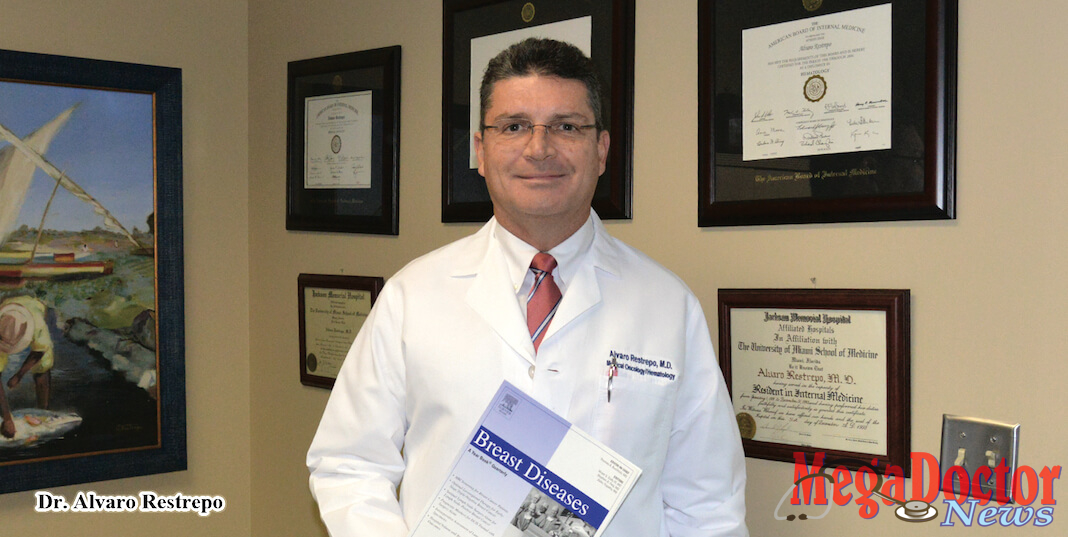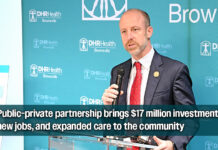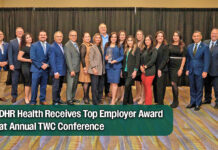The beginning of South Texas Research Group and Tumor Bank in the Valley
By Roberto Hugo Gonzalez
As originally published by Mega Doctor News in its newsprint edition October 2017
Álvaro Restrepo, M.D., an oncologist and hematologist physician, with more than twenty years in the field, says the cure for some cancers is already happening. He also pointed out that there is hope for more treatments as scientists continue their aggressive investigation of different types of cancer.
Dr. Restrepo specializes in internal medicine, medical oncology, and hematology. He is board certified in medical oncology. He is also the regional director for research in oncology for Texas Oncology-McAllen.
“The more we understand how the disease occurs, what environmental factor is in play, then that can be blocked or prevented; all of that is already happening,” he told Mega Doctor News. He gave the example of chronic myelogenous leukemia (CML), “Before it was an incurable disease but now thanks to the use of medication and some inhibitors, the outcome is better. A mutation called BCR-ABL disappears from the blood with a prescribed pill and many of those patients are cured.”
Dr. Restrepo is a physician with Texas Oncology McAllen, a cancer center known to be on the leading edge of treatment options. Texas Oncology McAllen also participates in a wide range of groundbreaking research paving the way for new breakthroughs in cancer care.
Not long ago, a cancer diagnosis was the end for anyone receiving the news. Today, hope increases by the minute as researchers and investigators in this field close the gap for the cure. Dr. Restrepo said, “I think it will be possible down the line because the more we investigate, the more we know, and more effective treatment alternatives become available.”
“Today, leukemia in kids, most of them is curable. Almost 70 to 80% of them are curable with long-term chemotherapy, as well as testicular cancer and also a lot of the patients with breast cancer, lung cancer, prostate cancer and colon cancer,” Dr. Restrepo said.
He said that in those cases, mortality has been decreasing over the last two decades, “Breast cancer survival in 1990 has changed as compared to now; before the average 5-year survival for breast cancer in 1990 was approximately 70%, now it has increased to almost 90%. Also, for stage 1 breast cancer, almost 99% of patients are alive after five years. So, I think a lot of progress has been accomplished,” he stated.
Dr. Restrepo told Mega Doctor News that before, it took a long time, more than 12 years to develop one cancer medication and to have a study completed. Today, with a better understanding of research, better communication through the internet, and other resources to design medications to block the disease, the results have improved to less than 7 years for the same results.
What causes cancer? “All cases have some host genetic predisposition, predisposing environmental factors, they are directly related to aging. Cancer development requires a triggering event that induces a driver mutation to develop uncontrolled cellular growth, cells become immortal, and continue to grow indefinitely. They cause damage to the organ of origin but also can travel to other places of the body via the bloodstream or lymphatic channels.”
What type of cancer diseases do you see here in the Rio Grande Valley? “In this area, a particularly underserved population has one of the highest incidence of obesity in the country and possibly the world. You can also add that there is a different diet and a specific genetic predisposition.” He said, “The type of cancers that we see here in the Valley, the most common are breast cancer, lung cancer, colon cancer, and prostate cancer.” In some cases, they see specific types of presentations in breast cancer. In his practice, it’s common to see young patients with advanced disease sometimes because of the lack of early diagnosis or preventive mammograms.
Dr. Restrepo pointed out that obesity is recognized as one of the most common risk factors for at least 13 types of cancer. Several studies suggest, almost 40% of all cancers are associated with obesity because obesity produces certain inflammatory substances that can trigger mutations and can make tumors grow.
“Nowadays obesity is a recognized risk factor almost at the same level as smoking. Smoking is going down in frequency, but obesity has been going up. Almost 75% of the population is either overweight or obese.” He continued, “In this area, we have a frequent presentation of fatty liver associated with liver cirrhosis and liver cancer.”
Have you seen cancer cases here that you have not seen before? “I think every patient; every case is unique because there are so many variables taken into account and we are all different.” He said, “We seem to be alike when seen through statistics, everybody seems to be in one group but when you go to an individual case, everybody is different.”
Dr. Restrepo said that even in brothers or sisters from the same father and mother, their genetic material is different from each other. He considers it is essential to see case by case, and that is when he tailors a treatment based on the unique properties of the situation. “Based on the characteristics of that tumor, the biology that generates the tumor, the comorbidities, the age, the family, and the surroundings and many other things are considered,” he said.
How can you convey a stronger message to a community already labeled as the fattest? “Since we already know what the problem is, now we have to find a solution. It’s simple, but at the same time difficult because it deals with the need to change our perspective on what we eat, the way we behave and changing our bad habits.”
Dr. Restrepo says that in this regard, the South Texas community is changing in some areas to help residents to enjoy a more active life. The number of parks increased during the last ten years, more gyms are now available in larger cities in the Valley, and most of the schools have dedicated areas for physical activities. He also mentioned that there are more outdoor events promoting exercise on a regular basis and he sees all of these as a plus.
Dr. Restrepo says that people are making changes because they realize there is a problem. “The important action to take now – is to lose the extra pounds.” The message is getting heard, although he says that it’s difficult because it takes time to change a behavior.
Dr. Restrepo is one of the most active physicians of the area, be that in taking care of his patients, cancer awareness, and research. In this regard, last year, he and a group of professionals started a project that he hopes is the seed for a more significant project in the future. “The idea is to create a research platform in the Valley.” For that purpose, they have created an entity by the name South Texas Research Group and Tumor Bank. He said, “We are going to create a platform to obtain tissue from cancer, donated by patients.”
The effort is to have clinical information available to students from the University of Texas Rio Grande Valley. “Also, for Texas’ oncologists and other researchers in the area or the country that can also collaborate with us to find answers to different cancer dilemmas, or interesting facts that can contribute to finding a cure for cancer.”
Dr. Restrepo said, “The fact that we have a unique population in the Valley will make this platform valuable to researchers. The uniqueness of the area is the combination of being Hispanic, young, underserved and the problem of having very high incidence of obesity and diabetes.”
“We have a unique genetic background and unique problems so finding solutions is going to help other people in the region solve those problems.” He continued, “The idea is to create a network to bring solutions to fight a complex disease.”
South Texas Research Group and Tumor Bank also aim to help and support medical students or young researchers that sometimes don’t find anyone to help them. The participation of Dr. Restrepo in this endeavor is crucial. He carries the influence of Texas Oncology McAllen, a group of dedicated oncologists participating in more than 250 research protocols locally since 1994.
“We are a huge network of researchers, and possibly the largest network of community oncologists in the country and maybe the world.” He said, “The experience, the opportunity that we have is unique so the key is to present this to the community and especially medical students so they can think and take advantage of this opportunity.”
Megan Keniry, Ph.D., and Wendy Whitehouse-Innis, Ph.D., form part of the UTRGV basic science professional team interested in cancer cell biology; Katia Moreno, RN, Texas Oncology research nurse director for South Texas, Nicolas Restrepo (Doctor Restrepo’s son) and Carlos Salas, both UTRGV college students, are also members of the group.
Dr. Restrepo says that the effort started about a year ago, at which time his team made contact with Dr. Steven A. Lieberman, who acted as the interim dean of the UTRGV School of Medicine. Now, they are planning to meet with Dr. John H. Krouse, the new dean of the School of Medicine.
Important Research Discovery:
“We have compiled cases from Non-HIV Kaposi Sarcoma patients for the last ten years, and we have discovered an increased incidence in Hispanic females in the population of South Texas, which is a rare disease,” he finalized. The support and the participation of the UTRGV School of Medicine are crucial and South Texas Research Group and Tumor Bank is ready to bring to the table the first abstract for which they already have IRB (institutional review board) approval from the university.


















